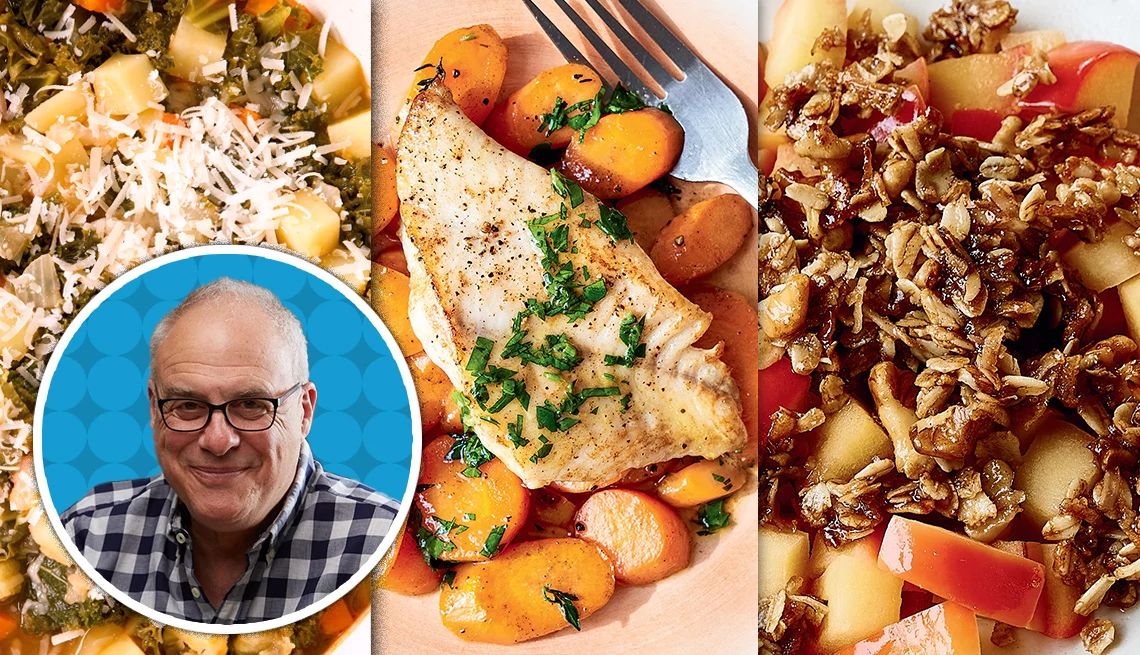AARP Hearing Center


Jump to recipes
Mark's Minestrone • Fish Fillets with Seasonal Vegetables • Skillet Crisp With Seasonal Fruit
I’m extremely lucky: I live on a farm that’s part of an organization run by my partner, which means I have most of the advantages of farm living without getting my hands dirty. But the largest of those benefits is eating seasonally via the farm’s CSA.
If that term means nothing to you, let me explain: “CSA” stands for “Community Supported Agriculture,” a now-standard scheme in which eaters (us) pay farmers in advance for a share of the season’s crop. The reward, in almost every year (I’ve been doing CSAs for 40 years and have only been disappointed once), is far more bounty than the original investment could possibly predict. More importantly, it's a guarantee that you’re eating locally and seasonally.
But you don’t have to live on a farm to learn to eat seasonally. Going to your local farmers market or farmstand or joining a CSA can give you those benefits. And seasonal shopping is even possible at chain supermarkets: just use your judgment and experience, and pay attention to where the food you’re buying comes from.
Of course, seasonal foods vary depending on where you live — Northerners are always shocked to find that tomatoes are out of season in the South’s summer, for example — but limiting fruits and vegetables from the Southern Hemisphere is a good way to start taking notice of your own seasonal nuances. Regardless of where you call home, you might be surprised at how much local produce there is in January, especially with the proliferation of greenhouses.
The recipes in this menu are written to encourage changing the vegetables and fruits you use with the seasons. No matter where you live or how you buy produce, I hope this menu inspires you to take advantage of seasonal produce — the most economical, environmental and joyful way to cook.
Mark’s Minestrone


Makes 2 bowl-size or 3 cup-size servings
Total time: about 45 minutes
My recipe for this Italian classic is based on how I learned to make this iconic soup from Italian home cooks: Learn the basic formula, then vary the vegetables at will. The ingredient list is written to let you decide which vegetables to include based on what’s in season at any particular time of the year — or which are long-storing, like onions, roots or potatoes. And it’s a terrific way to use up the odds and ends you have in the fridge. The instructions describe when to add them and provide cues to test for doneness. Like many soups, minestrone freezes well, so you might consider making a double recipe to sock a couple of bowls away for a rainy day.
Ingredients
- 2 tablespoons olive oil, plus more for drizzling
- 1/2 onion, chopped
- 1 carrot or celery stalk, chopped (or use 1/2 of each)
- 1 or two slices ham, prosciutto or cooked bacon (optional)
- About 1 cup chopped hard vegetables (like potatoes, winter squash, parsnips, turnips, celery root or rutabaga; peeled if necessary)
- Salt and pepper to taste
- 1 teaspoon dried oregano
- 3 cups vegetable or chicken stock, or water
- 1/2 cup chopped fresh ripe tomato (or, out of season, use drained diced canned tomatoes)
- About 1 cup chopped soft vegetables, peeled if necessary (like green beans; cooked, canned or frozen shell beans; zucchini or summer squash; or dark leafy greens like kale or collards)
- Chopped fresh parsley or basil (optional)
- Grated Parmesan cheese for garnish
Directions
Put 2 tablespoons oil in a 3- or 4-quart pot over medium heat. When it’s hot, add the onion and the carrot or celery. Cook, stirring, until the vegetables soften, 3 to 5 minutes. Add the meat if you’re using it and cook, stirring until everything turns golden, about 3 minutes more.
Add the hard vegetables; sprinkle with some salt and pepper and the oregano. Cook and stir for about a minute to combine everything, then add the stock or water and the tomatoes. Bring the soup to a boil, then lower the heat so the liquid bubbles gently. Cover and cook, stirring occasionally, until the vegetables are fairly soft and the tomatoes break apart, about 15 minutes. (At this point, you can cool and refrigerate the soup in an airtight container for up to 2 days. Proceed to Step 3 and add the soft vegetables as the soup reheats.)
Add the soft vegetables and adjust the heat again so the soup bubbles steadily. Cover and cook, stirring now and then, until the vegetables are quite tender, 5 to 10 minutes. Stir in the fresh herbs if you’re using them, and taste and adjust the seasoning. Serve right away, passing the cheese and extra olive oil at the table for garnishing and drizzling.































































You Might Also Like
Al Roker Releases ‘Recipes to Live By’ Cookbook
TV personality shares recipes for Mediterranean Farro Salad, Salmon Rice Bowls, and ShakshukaChef José Andrés’ Sublime Summertime Mediterranean Menu for Two
Try seared scallops with tzatziki, Cypriot potatoes and watermelon and feta salad
Celebrate Seafood with Five Delicious Dishes
Get recipes for crab cakes, smoked trout salad and miso cod ‘nobu’
Recommended for You